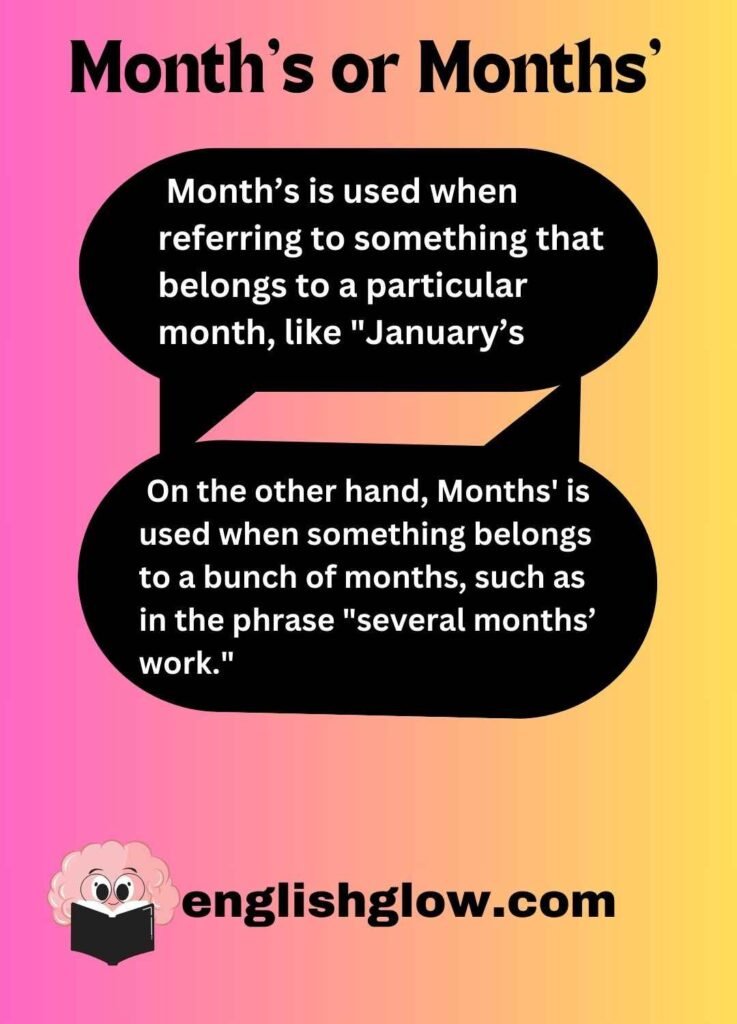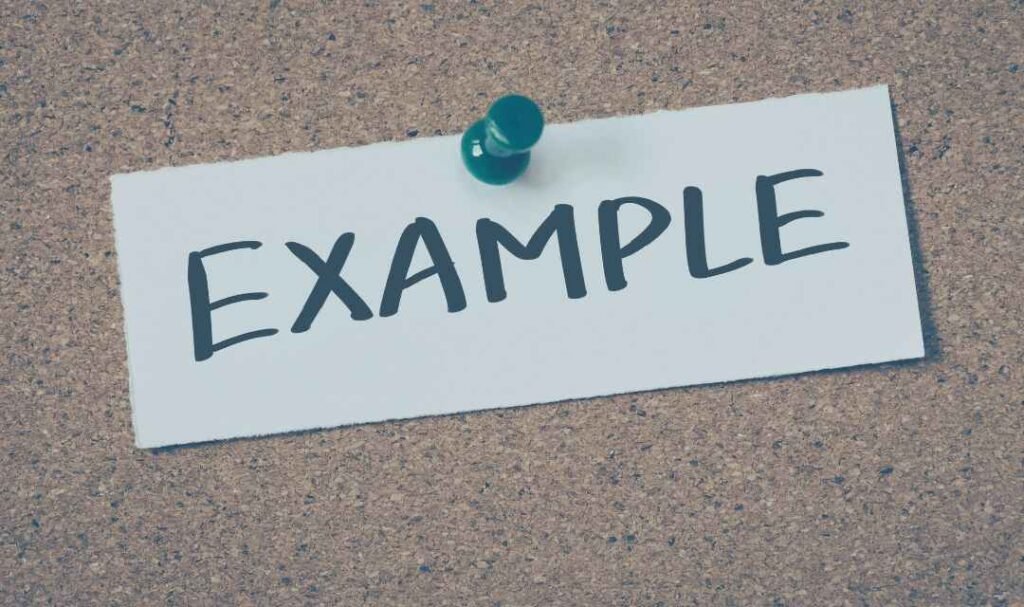“Understanding the difference between month’s and months’ is a key step to speaking and writing English more clearly! It all comes down to that little apostrophe and where you place it. Simply put: month’s (with apostrophe + ‘s’) shows that something belongs to just one month. Months’ (with ‘s’ + apostrophe) shows that something belongs to many months together. Think of it like labeling a box: month's is for one box, while months' is for a whole shelf of boxes. For example, “January’s weather” means the weather of that single month, January. “Three months’ work” means the work of those three months combined. Getting this right helps you express time and ownership accurately, making your grammar stronger and your meaning crystal clear. Don’t worry—it’s simpler than you think! I’ll explain it step-by-step with a helpful table, easy examples, and practical tips you can use right away.”
Which one? Month’s or Months’?

In my classes, I often find myself addressing a common yet intriguing question: Which form should we use—Month’s or Months’? This seemingly small detail can make a world of difference in writing. Understanding the distinction between these two forms is not just about grammar; it’s about conveying meaning with clarity and confidence.
When we use Month’s, we’re referring to something that belongs to a single month. For instance, when we say, “January’s weather,” we’re painting a vivid picture of the unique characteristics of that specific month. It’s as if January itself is sharing its story with us. On the other hand, Months’ comes into play when we’re talking about something that belongs to multiple months. Consider the phrase, “several months’ work.” Here, we’re acknowledging the collective effort, time, and dedication spread across a span of months—a testament to persistence and patience.
Grasping this subtle difference empowers you to wield these possessive forms with precision. Whether you’re describing the charm of a single month or the cumulative achievements of many, choosing the right form ensures your writing resonates with clarity and elegance. It’s a small step in grammar, but a giant leap in effective communication.
Understanding the Difference
When it comes to the English language, small details can make a big difference. One such nuance lies in understanding the distinction between “Month’s” and “Months’.” At first glance, these terms might seem almost identical, but their meanings and uses are worlds apart. Imagine holding a calendar in your hands, flipping through the pages, and realizing how a single apostrophe can change the entire context. “Month’s” refers to something belonging to a single month, like a month’s worth of memories or a month’s journey. On the other hand, “Months'” signifies possession or association with multiple months, such as months’ worth of planning or months’ accumulated experiences.
This subtle difference is not just a grammatical rule; it’s a gateway to expressing time, ownership, and relationships more precisely. Think about how often we reflect on time—whether it’s a month’s progress toward a goal or months’ worth of lessons learned. By mastering this distinction, we not only enhance our writing but also deepen our connection to the passage of time and the stories it holds. So, the next time you write, pause and consider the power of that tiny apostrophe—it’s more than a punctuation mark; it’s a storyteller.
You might enjoy reading: What Does “Let’s Blow This Popsicle Stand” Mean?
Differentiating Month’s and Months’ in Writing
Understanding the difference between month’s and months’ in writing is crucial. In my classes, I always stress the importance of using apostrophes correctly to indicate possession. For example, when something belongs to a specific month, such as “the month’s end,” it shows that the end is tied to that particular time.
However, when something is associated with multiple months, like “several months’ worth of research,” the apostrophe reflects possession over an extended period.To easily tell the difference, consider how many months are being referenced. If it’s one month, you should use month’s; if it involves multiple months, then months’ is the correct choice.
I always advise my students to pay attention to the context and the number of months in their writing to ensure they use possessive nouns correctly and convey their meaning accurately. Remember, mastering this distinction is a key step toward becoming a more precise and effective writer.
Table to understand
| [su_highlight background=”#c7ff58″]Aspect[/su_highlight] | [su_highlight background=”#c7ff58″]Month’s[/su_highlight] | [su_highlight background=”#c7ff58″]Months'[/su_highlight] |
|---|---|---|
| Meaning | Belongs to one month | Belongs to multiple months |
| Example | “The month’s report is ready.” | “The project took months’ time.” |
| Mark Position | Apostrophe before s | Apostrophe after s |
Contextual Concept
When you’re faced with phrases like ’12 month’s remuneration’, ’12 months’ remuneration’, or ’12 months remuneration’, it’s easy to feel confused. According to the New Oxford Style Manual, the use of an apostrophe in such constructions depends on the context.
In cases where 12 months’ remuneration is being discussed, the apostrophe is necessary because it shows possession—that is, the remuneration belongs to those 12 months. This is similar to how we say “three months’ wages,” where the wages are what you earn over three months.
However, when using time-based modifiers like “three months pregnant” or “three months in jail,” there is no need for an apostrophe. Here, the months are describing a state or condition, not indicating possession.
For example, in “three months of hard work,” no apostrophe is used because “of hard work” functions as an adjectival phrase. But in “three months’ hard work,” the apostrophe appears because “hard work” is a noun phrase. So, if you’re saying “12 months’ remuneration,” remember that the apostrophe reflects the quasi-possessive nature of the phrase, similar to “a month’s pay.”
Key Differences and Examples
In my years of teaching, I have always emphasized the significance of mastering possessive nouns and the correct use of apostrophes. These seemingly small details can make a world of difference in how we express ourselves. One area that often sparks confusion is the distinction between month’s and months’. Understanding this difference is not just a grammatical exercise—it’s a key to communicating with clarity and precision.
When we use month’s, we are referring to something that belongs to or is connected with a single month. For example, consider the sentence, “The end of the month is approaching.” Here, the phrase month’s ties the “end” specifically to that one month, evoking a sense of time slipping away, much like the fleeting nature of days. On the other hand, months’ is used when something is associated with multiple months. Take the sentence, “The research took several months, and the findings were groundbreaking.” This conveys the dedication and effort spread over a longer period, culminating in a rewarding outcome.
To distinguish between the two, I always encourage my students to pause and reflect: How many months are involved? If it’s just one, month’s is the way to go. If it’s more than one, months’ is the correct choice. This simple yet thoughtful approach ensures that possessive nouns are used accurately, allowing ideas to be conveyed with confidence and clarity.
Mastering this distinction is more than just a grammatical achievement—it’s a step toward becoming a more effective writer. By practicing these concepts and weaving them into your writing, you not only sharpen your skills but also create a deeper connection with your readers. After all, language is not just about rules; it’s about sharing ideas, emotions, and experiences in a way that resonates with others.
Clearing the Confusion

Clearing up the Confusion around month’s and months’ in writing is something I often need to address in my classes. Many students find it hard to grasp the difference, which is why I stress the importance of understanding how possessive nouns work and when to use them correctly.
For example, month’s is a form that shows something belongs to a specific month. If I teach my students to say, “The end of the month is coming,” it shows that the end is tied to that particular time. Here, the apostrophe and the letter “s” indicate possession.
On the other hand, months’ is used when something belongs to or is associated with multiple months. I often explain to my students that if they say, “The research took several months’ worth of data,” it means the research spanned a period covering multiple months. In this case, the apostrophe after the “s” shows the connection to more than one month.
To avoid confusion, it’s important to think about how many months are involved in your writing. If you’re talking about just one month, use month’s; if it’s about multiple months, then months’ is the right choice. By understanding these concepts and using them in context, you can improve your writing skills and get your message across more effectively.
Clarifying the Use of Month’s vs. Months’ with Examples
Understanding the distinction between month’s and months’ is a subtle yet essential aspect of grammar that often leaves even seasoned writers scratching their heads. As an educator, I’ve witnessed firsthand how this tiny apostrophe can create confusion, but mastering it can transform one’s writing from unclear to polished. Let’s explore this concept together, step by step, with relatable examples that will make it easier to grasp and apply in everyday writing.
Consider the term month’s. The apostrophe before the “s” signifies possession, indicating that something belongs to a single month. For instance, imagine you’re planning a project deadline. You might say, “The end of the month is approaching,” to emphasize that the deadline is tied to that specific month. Here, the apostrophe and the “s” work hand in hand to show ownership, creating a clear connection between the month and its end.
On the flip side, months’ (with the apostrophe after the “s”) is used when something belongs to multiple months. Picture yourself reflecting on a long-term project. You might write, “The research took several months’ time,” to convey that the effort spanned across numerous months. The placement of the apostrophe after the “s” is crucial here, as it signals that the possession extends to more than one month.
To navigate this grammatical nuance, ask yourself: How many months are involved? If it’s just one, use month’s; if it’s many, opt for months’. With a little practice and attention to detail, you’ll find that these small adjustments can significantly enhance the clarity and precision of your writing. Embrace this knowledge, and soon, you’ll wield the apostrophe with confidence, turning potential confusion into a tool for effective communication.
Example

Sentence: “The month’s budget is almost exhausted.”
Explanation: The budget belongs to or is related to a specific month.
Month’s:
Sentence: “I will finalize the month’s report by Friday.”
Explanation: The report is related to a specific month.
Month’s:
Sentence: “The month’s meeting is scheduled for tomorrow.”
Explanation: The meeting is associated with a specific month.
Month’s:
Sentence: “We are celebrating the month’s anniversary.”
Explanation: The anniversary belongs to or is related to a specific month.
Months’:
Sentence: “The months’ worth of savings were finally used for the vacation.”
Explanation: The savings belong to or are related to multiple months.
Months’:
Sentence: “The project required months’ worth of preparation.”
Explanation: The preparation involved multiple months.
Months’:
Sentence: “The months’ effort was visible in the final product.”
Explanation: The effort is related to multiple months.
Months’:
Sentence: “The months’ research resulted in a groundbreaking discovery.”
Explanation: The research took place over multiple months.
Months’:
Sentence: “They reviewed the months’ data before making the decision.”
Explanation: The data covers a period involving multiple months.
Months’:
Sentence: “The months’ of planning led to a successful event.”
Explanation: The planning took place over multiple months.
Month’s vs. Months’: Unraveling the Grammar Puzzle
Grammar can often feel like a labyrinth, and one of the trickiest corners to navigate is understanding the difference between “month’s” and “months’.” It’s a puzzle that has left many of my students scratching their heads, their pens hovering uncertainly over their papers. But here’s the good news: once you grasp the core idea, the confusion melts away, and clarity emerges like sunlight breaking through clouds.
The secret lies in the humble apostrophe and the letter s. These tiny marks hold immense power in shaping meaning. When you see “month’s,” it signifies something belonging to or associated with a single month. Picture this: you’re planning a project, and the deadline looms. You might say, “The end of the month’s schedule is approaching.” Here, the focus is on one specific month, and the apostrophe quietly claims ownership of that time.
Now, shift your gaze to “months’.” This form steps into the spotlight when multiple months are involved. Imagine a researcher reflecting on their work, saying, “The study required several months’ time.” The apostrophe here stretches its arms to embrace the collective span of those months, indicating possession over a broader period.
The key to mastering this distinction is simple: ask yourself whether you’re referring to one month or many. With a bit of practice and a mindful approach, you’ll soon wield these terms with confidence, crafting sentences that are not only grammatically precise but also a joy to read. After all, isn’t it satisfying to solve a puzzle and express yourself with clarity?
You might enjoy reading: Discover How Cream Rises to the Top:Definition & Key Examples
Frequently Asked Questions

- What is the difference between “month’s” and “months’”?
Answer: “Month’s” indicates possession or association with a single month, such as “The month’s budget.” “Months’” refers to possession or association with multiple months, like “The months’ worth of data.”
- When should I use “month’s”?
Answer: Use “month’s” when talking about something related to a specific month. For example, “The month’s meeting” means the meeting is associated with one particular month.
- When should I use “months’”?
Answer: Use “months’” when referring to something related to more than one month. For instance, “The months’ research” indicates research that spanned several months.
- Can you give an example of “month’s” in a sentence?
Answer: Sure! “The month’s report is due by Friday.” This sentence shows that the report is connected to a specific month.
- Can you provide an example of “months’” in a sentence?
Answer: Of course! “The months’ effort was visible in the final product.” This sentence implies that the effort spanned over several months.
- Why does the apostrophe come after the “s” in “months’”?
Answer: The apostrophe comes after the “s” in “months’” because it shows possession related to multiple months, indicating that something belongs to or is associated with several months.
- How do I remember when to use “month’s” versus “months’”?
Answer: Think about the number of months involved. Use “month’s” for one month and “months’” for multiple months. For example, “The month’s event” (one month) versus “The months’ preparations” (multiple months).
- Is “month’s” used for both singular and plural nouns?
Answer: No, “month’s” is used only for singular nouns. For example, “The month’s calendar” refers to one specific month.
- Is “months’” used for both singular and plural nouns?
Answer: “Months’” is used for plural nouns and indicates possession related to more than one month, such as “The months’ research” or “The months’ savings.”
- What is the key to mastering the difference between “month’s” and “months’”?
Answer: The key is understanding the context of your sentence. If you’re discussing something related to a single month, use “month’s.” If it involves several months, use “months’.” Practice and attention to detail will help improve accuracy.
Conclusion
Understanding the difference between “month’s” and “months’” is essential for clear and accurate writing. These terms may seem similar, but their meanings are distinct. Month’s is used when something belongs to a single month, while months’ refers to possession by multiple months.
Remember, the placement of the apostrophe—before or after the s—is key to showing whether you’re referring to one month or several. With practice and attention to these details, you’ll solve this grammar puzzle and use these terms with confidence!
You might enjoy reading: Master S Tongue Twisters for Quick Speech Improvement


